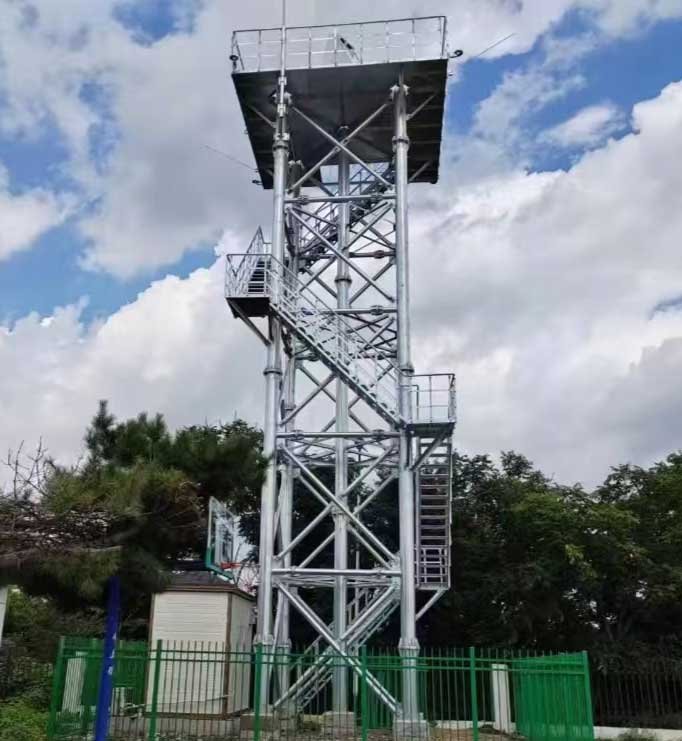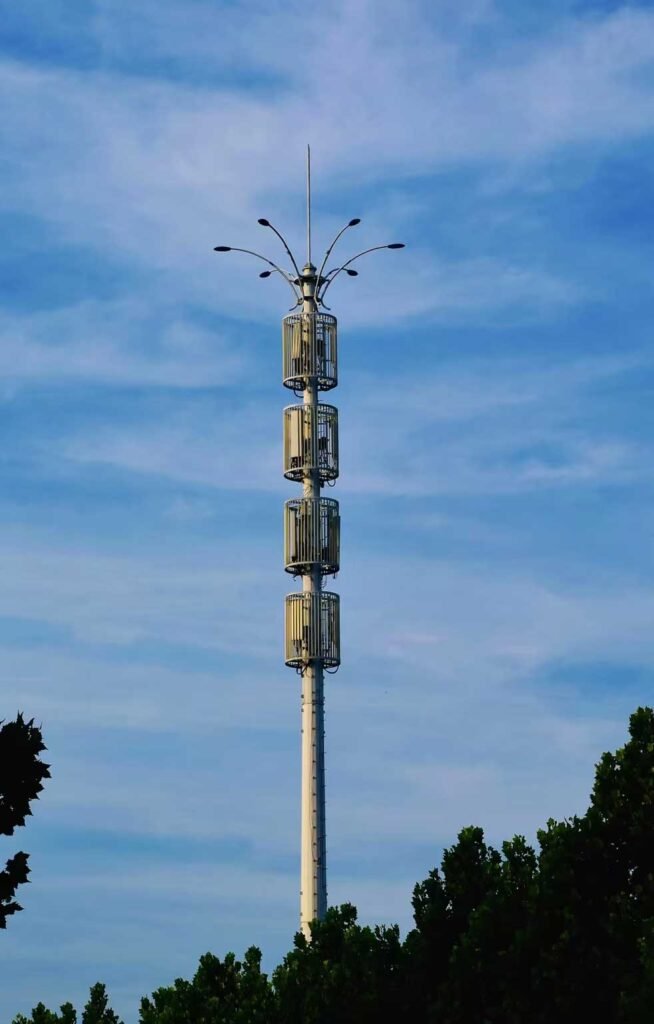-
Introduction: The Backbone of Mobile Communication and 5G Networks
-
What Is a Cell Mast? A Vital Component of Mobile Networks
-
Types of Cell Masts: From Monopole to Guyed Towers
-
Case Studies: Real-World Applications of Cell Masts
-
How Do Cell Masts Work in the Network?
-
Components of a Cell Mast: Key Elements for Connectivity
-
Applications of Cell Masts: Beyond Mobile Connectivity
-
The Future of Cell Masts: Key Trends and Innovations in 5G and Beyond
-
How to Choose the Right Tower Supplier: Tips and Considerations
-
FAQ: Common Questions About Cell Masts
-
Conclusion: Cell Masts Are Key to the Future of Connectivity
-
Call to Action
Introduction: The Backbone of Mobile Communication and 5G Networks
Cell masts, also known as telecom towers, are the unsung heroes of modern mobile communication. These tall structures, which support antennas, are responsible for transmitting and receiving the signals that power everything from mobile cellular towers to 5G towers. In a world that’s increasingly driven by mobile networks and internet connectivity, the role of cell masts in ensuring seamless communication cannot be overstated.
This article will walk you through the various types of telecom towers, explain how they work, and highlight the future trends driving the evolution of cellular masts. We’ll also take a closer look at the integration of 5G technology and other exciting innovations.
What Is a Cell Mast? A Vital Component of Mobile Networks
A cell mast is a tall structure designed to hold antennas that transmit and receive electromagnetic signals. These signals are used to deliver mobile services, including calls, internet data, and sometimes broadcast signals. A cell mast is an essential element of a cellular network, providing the infrastructure necessary for mobile devices to stay connected over long distances.
Whether you’re using a mobile cellular tower for a quick call or browsing the internet on your smartphone, cell masts are behind the scenes, ensuring that communication is possible.
Types of Cell Masts: From Monopole to Guyed Towers
Cell masts come in several designs, each tailored for specific environments. The most common types are:
1:Monopole Masts: An Efficient Solution for Urban Spaces
Monopole masts are simple, vertical steel structures, typically cylindrical or polygonal in shape. They require minimal ground space, making them ideal for urban environments, highways, commercial areas, and industrial parks where land use is limited.
Despite their simple structure, monopole towers have sufficient load-bearing capacity to support multiple antenna arrays, meeting the coverage needs of telecom operators. They are quick to construct, cost-effective to maintain, and visually modern—blending well with city architecture. In many cities, monopoles are disguised as lamp posts or trees (known as “stealth towers”) to reduce their visual impact on the surroundings.
2:Lattice Towers: The Best Choice for Multi-Antenna Installations
Lattice towers are steel-framed structures built with interlaced members, usually in triangular or square cross-sections. They offer exceptional structural stability and wind resistance, making them suitable for carrying heavy loads such as antennas, microwave dishes, surveillance cameras, and lightning protection devices.
Due to their strength and cost-effectiveness, lattice towers are widely deployed in suburban, rural, mountainous, and high-altitude regions. They provide wide-area coverage and are often used in backbone transmission networks. Heights typically range from 30 to 60 meters and can be customized based on site conditions and communication requirements.
Lattice towers are also easy to maintain and upgrade, allowing for flexible installation of additional equipment. They are the go-to option for medium to large-scale telecom infrastructure.
3:Guyed Masts: A Height-Cost Balanced Option
Guyed masts are tall, slender towers supported by multiple sets of guy wires anchored to the ground in various directions. This design allows the mast to reach significant heights—often 100 meters or more—without requiring heavy structural materials.
The key advantages of guyed masts include lightweight construction, low cost, and ease of transport and installation. They are ideal for deployment in wide-open spaces such as grasslands, deserts, farmland, or remote rural areas. Guyed towers are commonly used in broadcasting, mobile communications, and aeronautical navigation.
However, guyed masts require a large footprint due to the space needed for anchoring the guy wires, making them unsuitable for densely built urban areas.
Each type serves a different purpose, depending on the environment, cost, and performance requirements. Learn more about the difference between these towers in the Telecom Tower Design Guide.
Case Studies: Real-World Applications of Cell Masts
Case Study 1: Monopole Masts in New York City’s 5G Deployment
Challenge
New York City, one of the world’s most densely populated urban centers, presents several challenges for telecom infrastructure: limited ground space, dense high-rise buildings obstructing signals, and residents concerned about visual aesthetics. Traditional macro base stations (macrocells) struggle to meet the high-bandwidth, millimeter-wave (mmWave) requirements of 5G in such environments.
Solution
-
Deployment of monopole masts integrated with 5G small cells on urban structures like streetlights, building facades, and utility poles
-
Use of stealth designs (e.g., disguised as lamp posts or decorative columns) to reduce visual clutter
-
Close cooperation between telecom carriers (e.g., Verizon, T-Mobile) and municipal governments to optimize tower locations and obtain fast zoning approvals
Results
-
Achieved over 40% increase in 5G network coverage across New York City, especially in high-demand zones like Manhattan
-
Reduced overall deployment cost and time while maintaining urban visual harmony
Industry References
Case Study 2: Lattice Towers in India’s Rural 4G Expansion
Challenge
India’s vast rural landscape and scattered population densities have historically led to poor mobile coverage in remote villages. Telecom providers often avoided these areas due to the low expected return on investment (ROI) and limited access to electricity.
Solution
-
Utilization of lattice towers for their cost-efficiency, modular design, and high antenna capacity to support broad 4G coverage
-
Government’s “Digital India” initiative partnered with Jio, Airtel, and others to accelerate rural network expansion
-
Many sites powered by solar panels to address unreliable or absent electrical infrastructure
Results
-
Over 100,000 villages connected to 4G networks, driving digital adoption through e-banking (UPI), telemedicine, and online education
-
Lattice towers built with future-ready designs for seamless 5G upgrades
Industry References
Case Study 3: Guyed Masts in Africa’s Emergency Communication Networks
Challenge
Sub-Saharan Africa experiences frequent natural disasters (cyclones, floods, wildfires) and has vast underdeveloped regions where permanent telecom infrastructure is either non-existent or easily damaged. This severely hampers emergency communications and disaster response.
Solution
-
Rapid deployment of guyed masts for their low installation cost, tall height, and quick setup capabilities
-
Collaboration with international organizations such as the United Nations (UN) and GSMA, along with NGOs, to build temporary or semi-permanent communication towers
-
Use of hybrid energy systems (solar + diesel generators) to maintain uptime in off-grid conditions
Results
-
After the Cyclone Idai in Mozambique, emergency networks were restored within 48 hours, ensuring communication for humanitarian aid coordination
-
Guyed masts emerged as an economical long-term solution for rural and emergency coverage in multiple African nations
Industry References
How Do Cell Masts Work in the Network?
The primary function of a cell mast is to support antennas that transmit and receive radio signals to and from mobile devices. This is how they work:
Signal Transmission
Antennas on the telecom tower send signals carrying data, which are received by mobile devices (such as smartphones or tablets).
Signal Reception
The masts also receive signals from mobile devices and send them to base stations for processing, such as making a phone call or accessing the internet.
Network Integration
The cellular network is a collection of mobile cellular towers strategically placed to ensure continuous coverage. As you move from one area to another, your device seamlessly connects to the nearest telecom tower.
To explore more about the role of 5G towers in the future of mobile networks, read this 5G Mobile Deployment Report.
Components of a Cell Mast: Key Elements for Connectivity
A cell mast is made up of several crucial components that enable smooth and reliable mobile communication. Here’s a breakdown of its main elements:
| Component | Description |
|---|---|
| Mast Structure | The physical frame that supports antennas—can be a monopole, lattice, or guyed mast. |
| Antennas | Mounted on the mast, these devices transmit and receive electromagnetic signals. |
| Transmitters/Receivers | Located at the base, they convert signals between radio waves and data formats usable by mobile devices. |
| Power Supply | Provides energy to the system—can include grid electricity or renewable sources like solar panels. |
| Cable Systems | Transfers data and power between antennas, base stations, and other communication equipment. |
For an in-depth exploration of the power systems used in telecom infrastructure, visit IEEE Communications.
Applications of Cell Masts: Beyond Mobile Connectivity
Cell masts serve a range of functions in the telecommunications, broadcasting, and even emergency services sectors.
Telecommunications and Mobile Coverage
The main application of cell masts is to support cellular networks (2G, 3G, 4G, and 5G), enabling mobile devices to stay connected for calls, text messages, and internet browsing. These masts ensure broad coverage, from crowded urban areas to remote rural locations.
For more information on how telecom towers power mobile coverage, check out this Mobile Economy Report.
Broadcasting
Some cell masts also support broadcast towers for television and radio signals. In urban areas, a single mast might serve both telecom and broadcasting needs, maximizing space and reducing infrastructure costs.
Emergency and Temporary Services
During disasters or large public events, mobile towers can be rapidly deployed to restore mobile connectivity. These temporary towers provide essential communication during emergencies, ensuring that first responders and the public can stay connected.
Learn more about the use of mobile cellular towers in disaster response by visiting United Nations Disaster Relief.
The Future of Cell Masts: Key Trends and Innovations in 5G and Beyond
As mobile networks continue to evolve, so too does the technology behind cell masts. Here are some exciting developments shaping their future:
5G Network Integration
The advent of 5G technology is transforming cell masts. To meet the demands of 5G, networks will require more small, low-powered 5G towers. These small cells will be used alongside traditional larger masts to provide ultra-fast data speeds and low latency, especially in dense urban areas.
For insights on the challenges of 5G network deployment, read this 5G Americas Report.
AI and Smart Masts
The future of cell masts is also about becoming smarter. AI is being integrated into these masts to monitor signal quality, mast health, and energy consumption in real-time. This makes the system more efficient, reduces costs, and increases network reliability.
Learn about the integration of AI in mobile networks through this ResearchGate Article.

How to Choose the Right Tower Supplier: Tips and Considerations
When selecting a supplier for cell masts, consider these factors to ensure you choose the right one for your needs:
-
Experience and Reputation: Look for suppliers with a proven track record in telecom tower installations.
-
Regulatory Compliance: Make sure the supplier follows local zoning laws and regulations.
-
Cost and Maintenance: Consider the long-term cost of maintenance and services.
-
Technology Compatibility: Ensure the supplier’s masts are compatible with current networks and ready for 5G upgrades.
Top suppliers in the industry include American Tower, Crown Castle, and TowerXchange. For more details on telecom infrastructure suppliers, visit TowerXchange.
FAQ: Common Questions About Cell Masts
Q1: What is the difference between a monopole mast and a lattice tower?
Monopole masts are single, vertical poles, ideal for urban spaces where space is limited.
Lattice towers have a wider structure and offer more room for antennas, making them suitable for rural or high-altitude areas.
Q2: Are cell masts harmful to health?
The World Health Organization (WHO) states that the radiation emitted by cell masts is within safe limits. The levels of radiation are much lower than what people are exposed to daily from mobile phones.
For more information, visit the WHO’s Radiation Guidelines.
Q3: How tall are cell masts?
Cell masts typically range from 15 meters to 100 meters in height. Guyed masts are generally taller than monopoles or lattice towers due to their additional support structures.
Conclusion: Cell Masts Are Key to the Future of Connectivity
Cell masts are essential to the future of telecommunications, from supporting mobile networks to enabling 5G and beyond. As the demand for faster and more reliable connectivity increases, the role of cell masts will continue to grow, with new technologies like AI and 5G towers leading the charge. By selecting the right tower supplier, you can ensure your network stays ahead of the curve.
Call to Action
Looking to upgrade your telecom infrastructure with high-quality cell masts or 5G towers? Contact [Jing county Tianyi Tower Manufacturing Co., Ltd.] today to learn about our advanced tower solutions and how we can help future-proof your network.
🌐 Website: Visit Here
📧 Email: Contact Us
📱 WhatsApp: Click to Contact
📢 Telegram: Click to Contact




